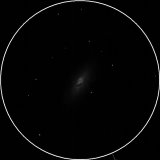
| MESSIER 64 |
|---|
RA: |
12h 56m 42s |
|
DEC: |
+21° 41' 00'' |
|
Type: |
Spiral galaxy |
|
NGC: |
4826 |
|
Magnitude: |
8.50 |
|
Surface brightness : |
12.70 |
|
Apparent dimensions : |
10.3'x5.0' |
|
Distance: |
19,000,000 ly |
|
Discovered 1779 by Edward Pigott. M64 is the famous Black Eye galaxy, sometimes also called the "Sleeping Beauty galaxy." The conspicuous dark structure is a prominent dust feature obscuring the stars behind. This feature also enables one to determine, or at least estimate, which of the galaxy's sides is nearer and which more remote; in case of M64, it seems that the southern side is nearer to us. The dust feature is well visible even in smaller telescopes. M64 was recently shown to have two counterrotating systems of stars and gas in its disk: The inner part of about 3,000 light years radius is rubbing along the inner edge of the outer disk, which rotates opposite and extends up to at least 40,000 light years, at about 300 km/sec. This rubbing process is probably the reason for the observed vigorous star formation process, which is currently under way, and can be observed as the blue knots imbedded in the peculiar dust lane on one side of the nucleus. It is speculated that this peculiar disk and dust lane may be caused by material from a former companion which has been accreted but has yet to settle into the mean orbital plane of the disk. M64 was discovered by Edward Pigott on March 23, 1779, just 12 days before Johann Elert Bode found it independently on April 4, 1779. Roughly a year later, Charles Messier independently rediscovered it on March 1, 1780 and cataloged it as M64. The dark dust feature was discovered by William Herschel who observed M64 twice in 1785 and 1789, and already compared it to a "Black Eye." M64 was identified rather early as a radio source also, which was cataloged as PKS 1254+21. While Sandage has classified it simply as an Sb spiral, in De Vaucouleurs it is of type (R)SA(rs)ab. Its nucleus is somewhat active, and shows rather weak emission lines of Seyfert 2 type. The distance of this galaxy seems to be not very well determined. Estimates range from 16 do 44 millions of light years. That the distance is not yet better known is a bit strange, as Cepheid variables in this galaxy should be in the reach of current telescopes, perhaps even the largest Earth-bound ones. Adopting this distance, the apparent extension of M64 of 9.3 arc minutes corresponds to a linear diameter of about 51,000 light years, and its visual magnitude of 8.5 to an absolute magnitude of -20.3 (uncorrected for absorption which is low at the galaxy's high galactic latitude). M64 forms a small group with the small irregular UGC 8024 (also known as NGC 4789 A or DDO 154). Together with M94 and a number of fainter galaxies, M63 is a member of a nearby group or cloud of galaxies, the Canes Venatici I (CVn I) Cloud or M94 group. No supernovae have been recorded in this galaxy up to now. M64 can be glimpsed with good binoculars, and is a rewarding object for small and medium-sized amateur telescopes. Visually, it exhibits an irregular shape with very uneven brightness and texture, overall a bright oval oriented about ESE-WNW, with a bright large core. The characteristic feature of the Blackeye Galaxy M64, the dark dust pattern, situated to the SSW direction from the nucleus, can be glimpsed with telescopes starting from 4 inch aperture, and get definitely resolved in 6-inch scopes. John Mallas even glimpsed the Black Eye feature in a 2.4-inch and found it easy in 4-inch, but more difficult in an 8-inch. |
||
VEDRAN VRHOVAC© 2006.-2007. |
